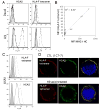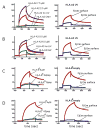HLA-F complex without peptide binds to MHC class I protein in the open conformer form
- PMID: 20483783
- PMCID: PMC3777411
- DOI: 10.4049/jimmunol.1000078
HLA-F complex without peptide binds to MHC class I protein in the open conformer form
Abstract
HLA-F has low levels of polymorphism in humans and is highly conserved among primates, suggesting a conserved function in the immune response. In this study, we probed the structure of HLA-F on the surface of B lymphoblastoid cell lines and activated lymphocytes by direct measurement of peptide binding to native HLA-F. Our findings suggested that HLA-F is expressed independently of bound peptide, at least in regard to peptide complexity profiles similar to those of either HLA-E or classical MHC class I (MHC-I). As a further probe of native HLA-F structure, we used a number of complementary approaches to explore the interactions of HLA-F with other molecules, at the cell surface, intracellularly, and in direct physical biochemical measurements. This analysis demonstrated that HLA-F surface expression was coincident with MHC-I H chain (HC) expression and was downregulated upon perturbation of MHC-I HC structure. It was further possible to directly demonstrate that MHC-I would interact with HLA-F only when in the form of an open conformer free of peptide and not as a trimeric complex. This interaction was directly observed by coimmunoprecipitation and by surface plasmon resonance and indirectly on the surface of cells through coincident tetramer and MHC-I HC colocalization. These data suggest that HLA-F is expressed independently of peptide and that a physical interaction specific to MHC-I HC plays a role in the function of MHC-I HC expression in activated lymphocytes.
Figures





Similar articles
-
Classical and nonclassical class I major histocompatibility complex molecules exhibit subtle conformational differences that affect binding to CD8alphaalpha.J Biol Chem. 2000 May 19;275(20):15232-8. doi: 10.1074/jbc.275.20.15232. J Biol Chem. 2000. PMID: 10809759
-
Functional characterization of HLA-F and binding of HLA-F tetramers to ILT2 and ILT4 receptors.Eur J Immunol. 2000 Dec;30(12):3552-61. doi: 10.1002/1521-4141(200012)30:12<3552::AID-IMMU3552>3.0.CO;2-L. Eur J Immunol. 2000. PMID: 11169396
-
Structure and function of the human MHC class Ib molecules HLA-E, HLA-F and HLA-G.Immunol Rev. 1998 Jun;163:129-38. doi: 10.1111/j.1600-065x.1998.tb01192.x. Immunol Rev. 1998. PMID: 9700506 Review.
-
Structural features impose tight peptide binding specificity in the nonclassical MHC molecule HLA-E.Mol Cell. 1998 Mar;1(4):531-41. doi: 10.1016/s1097-2765(00)80053-2. Mol Cell. 1998. PMID: 9660937
-
Structural studies on HLA-G: implications for ligand and receptor binding.Hum Immunol. 2007 Apr;68(4):220-6. doi: 10.1016/j.humimm.2006.09.003. Epub 2006 Oct 27. Hum Immunol. 2007. PMID: 17400055 Review.
Cited by
-
HLA-E and HLA-F Are Overexpressed in Glioblastoma and HLA-E Increased After Exposure to Ionizing Radiation.Cancer Genomics Proteomics. 2022 Mar-Apr;19(2):151-162. doi: 10.21873/cgp.20311. Cancer Genomics Proteomics. 2022. PMID: 35181585 Free PMC article.
-
Non-Classical HLA Class 1b and Hepatocellular Carcinoma.Biomedicines. 2023 Jun 9;11(6):1672. doi: 10.3390/biomedicines11061672. Biomedicines. 2023. PMID: 37371767 Free PMC article. Review.
-
A Distinctive Cytoplasmic Tail Contributes to Low Surface Expression and Intracellular Retention of the Patr-AL MHC Class I Molecule.J Immunol. 2015 Oct 15;195(8):3725-36. doi: 10.4049/jimmunol.1500397. Epub 2015 Sep 14. J Immunol. 2015. PMID: 26371256 Free PMC article.
-
Conformational Alterations of the Cell Surface of Monomeric and Dimeric β2m-Free HLA-I (Proto-HLA) May Enable Novel Immune Functions in Health and Disease.Curr Issues Mol Biol. 2024 Jul 4;46(7):6961-6985. doi: 10.3390/cimb46070416. Curr Issues Mol Biol. 2024. PMID: 39057057 Free PMC article. Review.
-
Structural insights into activation of antiviral NK cell responses.Immunol Rev. 2012 Nov;250(1):239-57. doi: 10.1111/j.1600-065X.2012.01168.x. Immunol Rev. 2012. PMID: 23046134 Free PMC article. Review.
References
-
- Accolla RS, Adorini L, Sartoris S, Sinigaglia F, Guardiola J. MHC: orchestrating the immune response. Immunol Today. 1995;16:8–11. - PubMed
-
- Bauer S, Groh V, Wu J, Steinle A, Phillips JH, Lanier LL, Spies T. Activation of NK cells and T cells by NKG2D, a receptor for stress-inducible MICA. Science. 1999;285:727–729. - PubMed
-
- Gonzalez S, Groh V, Spies T. Immunobiology of human NKG2D and its ligands. Curr Top Microbiol Immunol. 2006;298:121–138. - PubMed
-
- Lawlor DA, Zemmour J, Ennis PD, Parham P. Evolution of class-I MHC genes and proteins: from natural selection to thymic selection. Annu Rev Immunol. 1990;8:23–63. - PubMed
-
- Pamer E, Cresswell P. Mechanisms of MHC class I--restricted antigen processing. Annu Rev Immunol. 1998;16:323–358. - PubMed
Publication types
MeSH terms
Substances
Grants and funding
LinkOut - more resources
Full Text Sources
Other Literature Sources
Molecular Biology Databases
Research Materials

